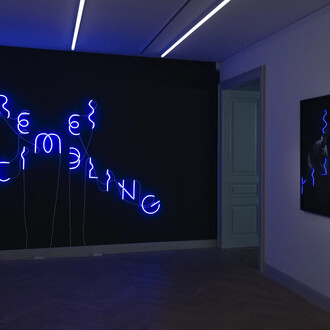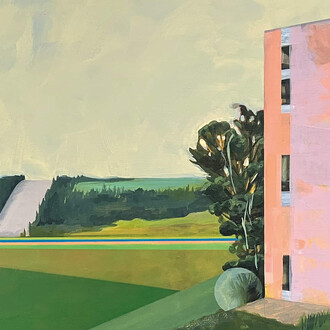There’s a kind of a distortion that happens with adoration.
(John Currin)
Gagosian is pleased to present an exhibition of paintings and works on paper by John Currin, made between 1989 and 2014.
Throughout his career, Currin has searched for the point at which the beautiful and the ugly are held in perfect balance. With his mastery of graphic and painterly techniques, combined with a predilection for the extreme, the humorous, and the ribald, his subjects challenge social and sexual taboos while subverting the historical linearity of artistic genres. References to Old Master portraits, pinups, pornography, and B-movies are channeled into ideational yet perverse images of women, from lusty nymphs to dour matrons.
Several paintings in this exhibition from different junctures in Currin’s trajectory reveal evolutions in technique and subject matter. Miss Fenwick (1996) depicts a mature blond woman in a simple blue dress, her smoothly painted body contrasting with the thick brushstrokes used for her face, which imparts a sense of desiccation and decay. With this simple contrast in texture, Currin suggests the dark undercurrents of social conventions, interrupting the contours of femininity with the charged idea of age. In Young Woman on a Lounger (2014), the woman’s long red hair frames her porcelain-skinned face as she gazes softly out at the viewer. And yet, despite the model’s sensual pose and careless affect, Currin’s slight distortions tip the painting toward the grotesque.
In 2011–12 Currin’s paintings were exhibited at the Frans Hals Museum in the Netherlands alongside masterpieces by the Dutch Golden Age painter Cornelis van Haarlem, revealing the clear historical links between the two artists’ treatment of flesh, surface texture, light, and shadow. These themes were explored afresh in 2017 with Gagosian’s special presentation of Currin’s drawings at Frieze New York. The career-spanning selection of graphic works exposed the complex networks of historical and pop cultural references (as well as the simple jokes) that come together seamlessly in Currin’s paintings. Chosen from over a hundred sketchbooks and notepads, the drawings—studies for prints and paintings, as well as still lifes, portraits, and loose watercolors, gouache, charcoal, ink, and pencil—show the evolution of Currin’s conceptual approach to the depiction of the human figure, concurrent with the development of his singular artistic process.
















![Karel Appel, Le coq furieux [The furious rooster] (detail), 1952. Courtesy of Kunstmuseum Bern](http://media.meer.com/attachments/de322f88933729d2014dc4e021d4a6694046a744/store/fill/330/330/c26a6c5ef5e2ed397d4a2e9bc00ac739c40ba8384f45f9ce1ed85adba600/Karel-Appel-Le-coq-furieux-The-furious-rooster-detail-1952-Courtesy-of-Kunstmuseum-Bern.jpg)